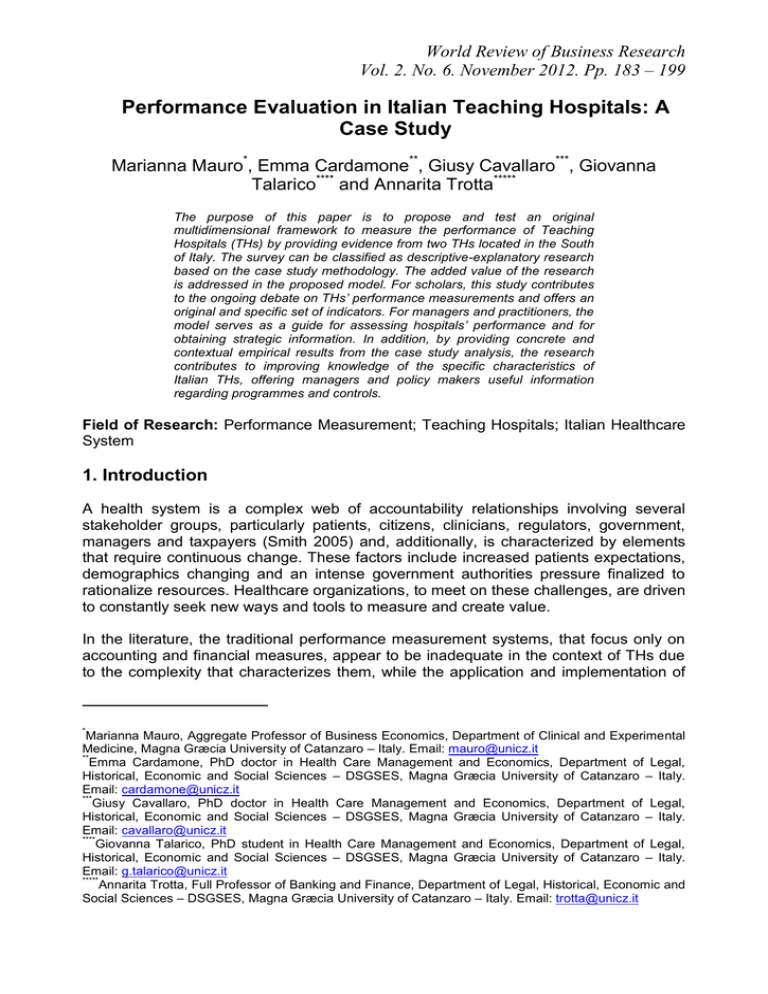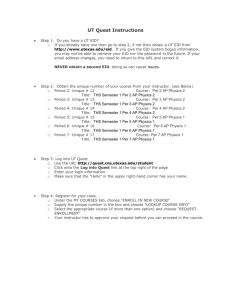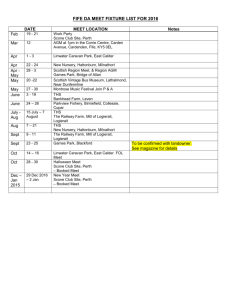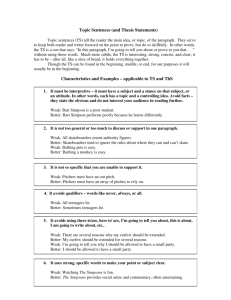Performance Evaluation in Italian Teaching Hospitals: A Case Study
advertisement

World Review of Business Research Vol. 2. No. 6. November 2012. Pp. 183 – 199 Performance Evaluation in Italian Teaching Hospitals: A Case Study Marianna Mauro*, Emma Cardamone**, Giusy Cavallaro***, Giovanna Talarico**** and Annarita Trotta***** The purpose of this paper is to propose and test an original multidimensional framework to measure the performance of Teaching Hospitals (THs) by providing evidence from two THs located in the South of Italy. The survey can be classified as descriptive-explanatory research based on the case study methodology. The added value of the research is addressed in the proposed model. For scholars, this study contributes to the ongoing debate on THs’ performance measurements and offers an original and specific set of indicators. For managers and practitioners, the model serves as a guide for assessing hospitals’ performance and for obtaining strategic information. In addition, by providing concrete and contextual empirical results from the case study analysis, the research contributes to improving knowledge of the specific characteristics of Italian THs, offering managers and policy makers useful information regarding programmes and controls. Field of Research: Performance Measurement; Teaching Hospitals; Italian Healthcare System 1. Introduction A health system is a complex web of accountability relationships involving several stakeholder groups, particularly patients, citizens, clinicians, regulators, government, managers and taxpayers (Smith 2005) and, additionally, is characterized by elements that require continuous change. These factors include increased patients expectations, demographics changing and an intense government authorities pressure finalized to rationalize resources. Healthcare organizations, to meet on these challenges, are driven to constantly seek new ways and tools to measure and create value. In the literature, the traditional performance measurement systems, that focus only on accounting and financial measures, appear to be inadequate in the context of THs due to the complexity that characterizes them, while the application and implementation of * Marianna Mauro, Aggregate Professor of Business Economics, Department of Clinical and Experimental Medicine, Magna Græcia University of Catanzaro – Italy. Email: mauro@unicz.it ** Emma Cardamone, PhD doctor in Health Care Management and Economics, Department of Legal, Historical, Economic and Social Sciences – DSGSES, Magna Græcia University of Catanzaro – Italy. Email: cardamone@unicz.it *** Giusy Cavallaro, PhD doctor in Health Care Management and Economics, Department of Legal, Historical, Economic and Social Sciences – DSGSES, Magna Græcia University of Catanzaro – Italy. Email: cavallaro@unicz.it **** Giovanna Talarico, PhD student in Health Care Management and Economics, Department of Legal, Historical, Economic and Social Sciences – DSGSES, Magna Græcia University of Catanzaro – Italy. Email: g.talarico@unicz.it ***** Annarita Trotta, Full Professor of Banking and Finance, Department of Legal, Historical, Economic and Social Sciences – DSGSES, Magna Græcia University of Catanzaro – Italy. Email: trotta@unicz.it Mauro, Cardamone, Cavallaro, Talarico & Trotta multi-dimensional instruments, such as the Balanced Scorecard (BSC) model, can contribute to optimising the efficiency of THs. In fact, THs are structures able to combine clinical care, teaching and research and, currently, must meet important challenges due to development of financial systems and their particular production process to which it relates a less efficiency and a difficulty to attribute costs to individual functions. The characteristics and problems of Italian Teaching Hospitals are similar to those of advanced economies. In particular, although performance management has grown in the Italian National Health Service (INHS) over the last fifteen years, it can still be considered a work in progress (Lega & Vendramini 2008), especially in some regions (such as those in the South), where the managerialisation of the health system has begun after much delay and there is an urgent need for a wide evaluation. Based on the above considerations, we believe that Italy represents a remarkable case for the study of the performance measurement of THs because, considering their threefold function of traditional healthcare, teaching and research (Bevan & Rutten 1987), have specific characteristics in terms of costs, revenues and activities, and, also, for the issues and vulnerabilities that characterise different health care systems due to high costs and inefficiencies, which threaten the survival of these hospitals (Lega & Vendramini 2008). Moving from these considerations, the study/research aims to propose and test an original multidimensional framework for measuring the performance, realized ad hoc on THs’ threefold activity, by providing prior empirical evidence, through a survey in two THs, Mater Domini and Martino, which are located in two regions of South-Italy (Calabria and Sicily, respectively). The research interest in the evaluation of the performance of the Mater Domini and Martino hospitals is primarily the result of regional actions related to the reorganisation of hospital networks. Such reforms result in agreements (deficit recovery plans) with the Italian government, which aim to eliminate deficits in health service. The THs investigated are part of these programmes. Consequently, the study contributes to the current debate on the use of a multidimensional method for measuring the performance of teaching hospitals. In particular, by providing concrete and contextual results for the case studies, the research contributes to improving knowledge of the specific characteristics of THs. Also, although performance evaluation studies can offer useful information for all stakeholder groups, our findings are specifically intended for hospital managers, because they need information to ensure that their organisations are able to meet their objectives, and for policy makers, because they require performance information to ensure that the management is performing in accordance with the stated intentions. The paper is organised as follows. In the next section, the literature review is presented. The third section presents the research methods and THs performance measurement 184 Mauro, Cardamone, Cavallaro, Talarico & Trotta model; the fourth section provides the empirical results and the final section shows some conclusions also highlighting the limitations of the study. 2. Literature Review Performance Measurement (PM) has generated significant interest over the years. Most scholars (Adair, Simpson & Casebeer 2006; Smith & Goddard 2002) generally identify four stages of the PM process (Figure 1). Figure 1: Performance Measurement Process Most studies are unanimous to recognize that the critical phase of this process concerns the criteria for selecting measures. Several portfolio approaches, which include both non-financial and financial measures (Kueng 2000), have been developed, but the most popular framework in business is the BSC proposed by Kaplan and Norton (1992). Guidelines pertaining to the criteria for index selection are numerous, and the literature is inconsistent (Adair, Simpson & Casebeer 2006). Greater emphasis is given to meaningful, strategic and most importantly evidence-based topics (Gross et al. 2000). However, some major issues must be considered with regard to measure selection: the growth in the number of indicators (Simons 2010) and the types of measures and their limitations (Adair et al. 2003). Moreover, scholars and professionals are in line with the suggestions by Brown (1996), according to which an ideal number of measures is between 15 to 20 to avoid information overload. An ideal indicator should have several key characteristics (Adair et al. 2003; Mainz 2003) (Table1). Table 1: Indicator Key characteristics 185 Mauro, Cardamone, Cavallaro, Talarico & Trotta Several authors (Kaplan & Norton 2001; Zelman, Pink & Matthias 2003) agree with the need to articulate a multidimensional framework and to consider process dimensions as complementary to outcomes or results to measure non-profit organisations. Therefore, all of the indices should be chosen to fulfil specific measurement objectives in specific hospitals (Yap et al. 2005). Finally, regarding teaching hospitals, the literature highlights governance complexity, coordination issues (Smith & Whitchurch 2002) and lower efficiency compared with nonTHs (Schreyögg & Von Reitzenstein 2008). The growing number of BSC applications to THs (Kaplan & Norton 2001; Meliones et al. 2001) confirms the significance of the application, the potential of the instrument that needs, however, of ad-hoc adjustments. About this and, also, considering the need to extend the empirical evidence in the context of THS, this research contributes to corps of knowledge for a deeper comprehension of performance in the specific area of teaching hospitals that, in the broader context of health system, represents an underdeveloped area in the field of performance measurement. In addition, provide evidence of the application of a model of performance measurement may represent a teaching tool for other organizations and will contribute to better interpretation and use of performance information in order to improve and guide future actions. 3. Methodology The purpose of the research is to support hospitals (THs) in assessing their performance providing them: - A multidimensional instrument for measuring the performance, composed by an original and specific set of indicators focused on THs’ threefold activities, through which translating results into actions for improvement. - Evidence of the application model of performance measurement in two Italian case studies that can represent a teaching tool for other THS. In order to latter point, we have realized an empirical study testing a multidimensional framework, for 2009 and 2010, in two Italian THs that are located in South-Italy: Mater Domini hospital and Martino hospital. 3.1 Research Method Considering the approach exploratory of the research, the survey methodology is based on case studies. The cases can be used to describe a phenomenon that contributes to proposals of possible explanations of general order. There are differing opinions regarding the effectiveness of the case study method. Some authors emphasise the limited extent of a case study to supply explanations that can be generalised; other authors (Yin 1994; Patton 2002) claim that a single case study can be generalised because it can be assimilated into an experiment. Because this research aims to describe phenomena through the representation of organisational reality, the case study methodology is appropriate. 186 Mauro, Cardamone, Cavallaro, Talarico & Trotta The selection of case studies is one of the most important aspects to consider. Patton (2002) has suggested several theoretical sampling strategies, but according to Yin (1994), the analysis can be based on a single case or on multiple cases. A single case can be used to confirm a theory or to represent a unique or extreme situation. The choice of different cases indicates the preference for a logical replication of the results. The cases that are the objects of this survey, Mater Domini Hospital (in Calabria) and Martino Hospital (in Sicily), have been selected to guarantee both methodological severity because similar cases for some aspects have been analysed and scientific involvement because both of the regions suffer from the typical development defects observed in North and South Italy. 3.2 THs Performance Measurement Model The framework has been developed by the research group and has involved hospital management teams through the following logical process. In the first process step, to ensure its applicability to non-profit organisations, the BSC framework has been modified beginning with the hospital missions (Kaplan & Norton 2001) and by identifying the critical performance perspectives and the relations among perspectives (Figure 2). Figure 2: The relations among perspectives According to their threefold mission of care, teaching and research, the THs influence the effectiveness of care activities (effectiveness perspective) and focus on the efficiency and productivity of care activities (efficiency and productivity perspective). Both in clinical and in economic terms, they also ensure appropriate levels of care in the quality of service provided (patient perspective), develop research and training for future doctors (teaching and research perspective), and pursue operational efficiency objectives (economic and financial perspective). Moreover, by creating value for patients, THs become more "attractive", increase the volume of care delivered and improve their competitive position (competitive perspective). 187 Mauro, Cardamone, Cavallaro, Talarico & Trotta In the second process step, for each dimension, an appropriate set of performance indicators is defined. Regard this, in Section 2, we compared various alternative criteria for the selection of measures. In according with the suggestions from Veillard et al. (2005), we proposed key performance indicators on the basis of the main guidelines outlined by the doctrine and calibrated for the specifics of certain cases and on the basis of discussions with local professionals. Table 2 presents the data collection of the indicators used to measure THs’ performance. Several indicators that we used are based on the Italian Commission‘s guidelines (Commission for the Guarantee of Statistical Information 2002) or on research identifying the hospitals that have realised the best performance (Thomson Reuters 2008), other indicators provide relevant information to major stakeholders (Table 2.1). However, some additional clarifications on the framework should be provided. Regarding the patient perspective, the following questionnaire tools were used. For Mater Domini Hospital, the questionnaire was administered to inpatients and users awaiting outpatient care. For Martino Hospital, patient satisfaction was analysed by examining data from a survey that was conducted in 2009 by TH management; 427 questionnaires were administered and completed at three Operating Units (OUs). Concerning the teaching and research perspective, some proxies have been chosen, and the Impact Factor (IF) was used specifically as a measurement tool for research activities. The IF was calculated by considering all of the publications of the directors of OUs at Mater Domini TH and all of the publications of the directors of the Departments of Integrated Care Activities at Martino Hospital and then scoring each article according to the magazine that published it (based on the database for the Journal of Citation Reports of 2007, 2008 and 2009). These scores are subsequently summed for each item to obtain the total IF of the articles that have been published over the years for each university hospital. Finally, Figure 3 highlights the data sources. Figure 3: The data sources 188 Mauro, Cardamone, Cavallaro, Talarico & Trotta Table 2: The Data Collection Framework 189 Mauro, Cardamone, Cavallaro, Talarico & Trotta 190 Mauro, Cardamone, Cavallaro, Talarico & Trotta Table 2 (Continued) 191 Mauro, Cardamone, Cavallaro, Talarico & Trotta Table 2.1: Relevance factors of the indicators Several factors make us believe that this model can contribute to generate substantial and incremental value in the context of THS. First, considering that the context of THS appears underdeveloped for the application of an integrated model for performance measurement. Second, to the peculiarity of THS for which the application of a multidimensional model of performance measurement, considering the tripartite mission of healthcare, teaching and research, can lead to formulate interesting conclusions and, at the same time, can be considered as a potential support and guidance to other organizations in the sector. Therefore, for scholars, this framework contributes to the ongoing debate on THs’ performance measurements by proposing an original set of indicators focused on THs’ threefold activities. Finally, this contribution can be a good base for future potential research to be conducted in the area and offers suggestions about as THs can effectively undertake a multidimensional development process. 4. Findings: The Case Studies of the Mater Domini (Calabria) and Martino (Sicily) Hospitals1 The Mater Domini Hospital, established in 1995, is the only TH in Calabria, while the Martino university hospital, in Messina, is considered to be one of the most important hospitals in Sicily. The first economic and financial measurements have determined the conditions of the profitability of the organisation during the production of hospitalisation services (day hospital and ordinary hospitalisation) and ambulatory care activities (Table 3). In the following section, Mater Domini hospital is identified as THa, and Martino hospital is identified as THb. 192 Mauro, Cardamone, Cavallaro, Talarico & Trotta Table 3: Economic and Financial Perspective According to the index of economic independence, we can observe a partial ability of THb to reintegrate traditional management costs from patient assistance; these costs decreased slightly in 2009. However, although THa records an increase in the number of discharged patients (approximately 700 units) and in outpatient activity (approximately 16,000 operations), the hospital is unable to cover its operating costs with typical revenue. For the calculation of cost of sales see Table 3.1. Table 3.1: Calculation of cost of sales With regard to the second indicator, the main revenues of THb are derived from operating activities; the revenues for THa are essentially derived from operating grants, which are resources transferred by the local governmental bodies for activities and for which the DRG cannot be calculated. For the calculation of the production value see Table 3.2. Table 3.2: Calculation of production value With regard to the competitive perspective (Table 4), the THa data show a low inward mobility and an index of attraction that almost doubled from 2008 to 2009; this result 193 Mauro, Cardamone, Cavallaro, Talarico & Trotta arises because of the increase in the number of discharged patients outside the region (48%) and the decrease in the total number of discharged patients (approximately 5%). Table 4: Competitive Perspective The competitiveness of the Calabria THa presents contrasting elements: the hospital seems to be rising with regard to the volume of business conducted in terms of its market share, whereas it shows a decrease in the volume of health care services provided, including both hospitalisation and ambulatory care activities. The increase in the index is primarily the result of a reduction of approximately 54,000 units of inpatients in the region rather than the slight increase in the volume of services provided by the university hospital. In the case of THb, the analysis of the competitive profile indicators indicates a steady capacity of the hospital to attract patients from outside the catchment area. This result seems to follow an opposite trend compared to that of the regional situation, which is characterised by extremely high levels of passive patient mobility; the nature of the university structure would be expected to bring a higher capacity of ‘extracatchment’ attraction. The slightly decreasing trend in discharges—and therefore in admissions—is probably a result of fewer hospital admissions for all outpatient and/or day hospital services because of the stricter healthcare assistance controls that were enforced from 2007 to 2009 within the re-entry plan. With the aim of assessing the ability of the THs to provide appropriate responses to patient needs, we propose the performance indicators listed in Table 5. Table 5: Effectiveness Perspective To measure the patient response to the treatment performed in the hospitalisation regime, we used a proxy variable that considers the response to treatment as positive if a patient does not return to the hospital within a period of 30-45 days after discharge. For both hospitals, attention should be focused on lowering the rate of returns (the response to treatment index remains high, with values of more than 90%), which is considered here as a positive response to treatment. However, fewer returns could indicate non-positive outcomes, such as death, or could indicate that a patient has chosen to go to another hospital because he/she has unfavourably judged his/her stay in the hospital. As shown in Table 4, there is a substantial consistency in the value of the indicators of the THb in terms of effectiveness; rather, the incidence of health treatment complications has increased in the THa during this period. In 2009, such 194 Mauro, Cardamone, Cavallaro, Talarico & Trotta complications have again increased for complex diagnoses, especially for cardiovascular and liver diseases. In accordance with this change, the mortality rate is also increasing; in 2009, it reached 0.66%. The evaluation of hospitals efficiency was conducted using two sets of indicators: one set for efficiency and clinical healthcare productivity profiles and another set for efficiency and economic productivity profiles. Based on our analysis of the first set of indicators, we observed a slight increase in the overall clinical healthcare productivity of THb (Table 5.1). Table 5.1: Efficiency and Productivity Perspective: Clinical Perspective With regard to the THa, the analysis highlights that the average length of stay showed a slightly upward trend from 2008 to 2009. The average weight of the performance indicated an average value that is higher than one unit per year and failed to reveal substantial differences in the heaviness of the series during the period of observation. The second set of indicators, relative to economic productivity, shows a general maintenance of hospital efficiency levels and higher utilisation of available beds (Table 5.2). Table 5.2: Efficiency and Productivity Perspective: Economic Perspective For the THb, the joint observation of the turnover index-OH and the average hospital stay shows a slight increase in the efficient use of beds with a higher number of admissions and shorter hospital stays. However, the improvement of the indicators is not determined by an increase in the levels of services provided; rather, it is determined by a reduction in day hospital beds. The turnover index-OH for hospitalisation at the THa has increased as a result of the volume of discharged patients (because the number of beds remains constant); in contrast with day hospital/day surgery admissions, the number of DH beds has been reduced by six units. Specifically, three units have been eliminated, and three units 195 Mauro, Cardamone, Cavallaro, Talarico & Trotta have been moved to the DS system. From 2008 to 2009, the total allocation (OH, DH, and DS) of beds has decreased from 166 to 163 units. The facility utilisation rate indicates an adequate capacity of hospital utilisation. When we observe that the turnover index increases and the average stay remains constant, we can conclude that the hospital appears to be properly used. However, such analysis must also account for values that are not negligible, such as the average weight: more weight leads to more complex diseases and, therefore, to greater use of the structural and human resources. Regarding the patient perspective and the questionnaire submission for Mater Domini Hospital, the preliminary findings currently allow us to draw a positive conclusion regarding the professionalism of the medical and nursing staff and the hygiene/environmental conditions of the TH. The following considerations may be presented with respect to Martino Hospital (Table 6). Table 6: Patient Perspective As for the teaching and research perspective (Table 7), the teaching values remained fairly constant during the three-year period for both of the observed hospitals in terms of research data. Due to a steady increase in the number of scientific publications, the impact factor of THa improved significantly during the study period. Table 7: Teaching and Research Perspective 196 Mauro, Cardamone, Cavallaro, Talarico & Trotta 6. Conclusion This study aims to test, with an exploratory approach, an original multidimensional measurement model for assessing teaching hospitals’ performance. To test the framework, a survey was conducted of two case studies located in the South of Italy. The cases are particularly relevant for the research because both of the regions suffer from the typical development differences between the North and the South of the country, and they are characterised by significant economic and financial burdens. Considering the prior results from empirical analysis, we can conclude that the application of BSC model highlights, immediately, the crucial points of the THs' production process. In particular, THs are inefficient due to the high costs of teaching and research activities combined with a low level of competitiveness; thus, they are currently less attractive based on their scarce growth perspectives. However, they are clinically effective because they show a high rate of response to treatment and are used properly. Their activity is characterised by a high level of complexity with respect to diseases and by a low level of medical staff productivity, which is probably associated with their research and training activities. Therefore, performance measurement allows focusing on the strengths and weaknesses that may become a starting point for improve results in future perspective. Moreover, the analysis of cases has highlighted assets and limitations of the proposed framework. As mentioned in section 3, we tested a framework that is the result of the first phase of our study and will be subjected to further adjustments and integrations. The limitations primarily concern three issues: First, it is necessary to incorporate insights regarding risk management, funding systems, financial aspects of innovation, and learning and growth perspectives. Second, the level of analysis should be enhanced because some indicators may be more significant for a particular operating unit level or for a specific disease. Third, an important limitation concerns the reliability and validity of the indicators. In fact, many indicators may be more significant considering the hospital development policies. However, because the performance dimensions must be adapted in ways that are specific to each hospital (Yap et al. 2005), the model design and measure selection requires the consideration of specific characteristics of the observed hospitals, their sizes, their main specialties and features relating to the external environment in which they have been operating. Therefore we can conclude that although some indicators could have low validity in general terms, the proposed model and the selected measures are consistent with the specific characteristics of the analysed THs and with the main stakeholders of the hospitals. Endnotes 1. Some of the data related to Martino Hospital are derived by Barresi et al. (2010). 197 Mauro, Cardamone, Cavallaro, Talarico & Trotta References Adair, CE, Simpson, L, Birdsell, JM, Omelchuk, K, Casebeer, AL, Gardiner, HP, Newman, S, Beckie, A, Clelland, S, Hayden, KA & Beausejour, P 2003, Performance Measurement Systems in Health and Mental Health Services: Models, Practices and Effectiveness. A State of the Science Review, Alberta Heritage Foundation for Medical Research, Alberta. Adair, CE, Simpson, E & Casebeer, AL 2006, ‘Performance Measurement in Healthcare: Part II – State of the Science Findings by Stage of the Performance Measurement Process’, Healthcare Policy, vol. 2, no.1, pp. 56-78. Barresi, G, Cardamone, E, Cavallaro, G, Mauro, M, Marisca, C & Trotta, A 2010, ‘Measuring the Performance of Teaching Hospital. The Case of Calabria and Sicily’, paper presented to the AIDEA Annual Conference on Pubblico e non profit per un mercato responsabile e solidale, Bocconi University, Milan, 21-22 October. Bevan, G & Rutten, F 1987, ‘The organisation and Functions University Hospital in Different Countries’, Finance Accountability & Management, vol. 3, no. 2, pp. 77115. Brown, MG 1996, Keeping Score: Using the Right Metrics to Drive World-Class Performance, Productivity Press, New York. Commission for the guarantee of statistical information 2002, Definizione di un set di indicatori per il monitoraggio e la valutazione dell’attività sanitaria, research report 02-03, April, Presidency of the Council of Ministers, <http://www.governo.it/ Presidenza/statistica/rapporti_indagine. html>. Gross, P, Braun, BI, Kritchevsky, SB & Simmons, BP 2000, ‘Comparison of Clinical Indicators for Performance Measurement of Health Care Quality: A Cautionary Note’, British Journal of Clinical Governance, vol. 5, no. 4, pp. 202-211. Kaplan, RS & Norton, DP 1992, ‘The Balanced Scorecard-Measures that Drive Performance’, Harvard Business Review, January-February, pp. 71-79. Kaplan, RS & Norton, DP 2001, The Strategy-Focused Organization: How Balanced Scorecard Companies Thrive in the New Business Environment, Harvard Business School Press, Boston. Kueng, P 2000, ‘Process Performance Measurement System: A Tool to Support Process-Based Organizations’, Total Quality Management, vol.11, no. 1, pp. 6785. Lega, F & Vendramini, E 2008, ‘Budgeting and Performance Management in the Italian National Health System (INHS)’, Journal of Health Organization and Management, vol. 22, no. 1, pp. 11-22. Mainz, J 2003, ‘Defining and classifying clinical indicators for quality improvement’, International Journal for Quality in Health Care, vol. 15, no. 6, pp. 523-530. Meliones, JN, Ballard, R, Liekweg, R & Burton, W 2001, ‘No Mission – No Margin: It’s That Simple’, Journal of Health Care Finance, vol. 27, no. 3, pp. 21-29. Patton, MQ 2002, Qualitative Research & Evaluation Methods, 3rd edn, Sage Publications, Thousand Oaks. Schreyögg, J & Von Reitzenstein, C 2008, ‘Strategic Groups and Performance Differences among Academic Medical Centers’, Health Care Management Review, vol. 33, no. 3, pp. 225-233. Simons, R 2010, Seven Strategy Questions: A Simple Approach for Better Execution, Harvard Business Review Press, Boston. Smith, PC 2005, ‘Performance Measurement in Health Care: History, Challenges and Prospects’, Public Money & Management, vol. 25, no. 4, pp. 213-220. 198 Mauro, Cardamone, Cavallaro, Talarico & Trotta Smith, PC & Goddard, M 2002, ‘Performance Management and Operational Research: A Marriage Made in Heaven?’, Journal of the Operational Research Society, vol. 53, no. 3, pp. 247-255. Smith, T & Whitchurch, C 2002, ‘The Future of the Tripartite Mission: Re-examining the Relationship Linking Universities Medical Schools and Health Systems in Higher Education Management and Policy’, Journal of the Programme on Institutional Management in Higher Education, vol. 14, no. 2, pp. 39-52. Thomson Reuters 2008, 100 Top Hospitals: Performance Improvement Leader, 5th edn, Ann Arbor, Michigan. Veillard, J, Champagne, F, Klazinga, N, Kazandjian, V, Arah, OA & Guisset, AL 2005, ‘A performance assessment framework for hospitals: the WHO regional office for Europe PATH project’, International Journal for Quality in Health Care 2005, vol. 17, no. 6, pp. 487-496. Yap, C, Siu, E, Baker, GR & Brown, AD 2005, ‘A Comparison of System Wide and Hospital-Specific Performance, Measurement Tools’, Journal of Healthcare Management, vol. 50, no. 4, pp. 251-262. Yin, R 1994, Case Study Research: Design and Methods, 2nd edn, Sage Publishing, Beverly Hills. Zelman, WN, Pink, GH & Matthias, CB 2003, ‘Use of the Balanced Scorecard in Health Care’, Journal of Health Care Finance, vol. 29, no. 4, pp. 1-16. 199




